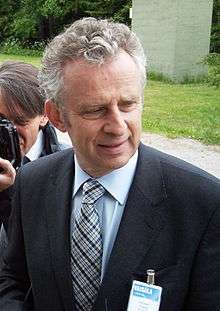Richard Friend
| Sir Richard Friend | |
|---|---|
 Friend in Finland in 2010 | |
| Born |
Richard Henry Friend 18 January 1953[1] London[2] |
| Fields | |
| Institutions | |
| Alma mater | |
| Thesis | Transport properties and lattice instabilities in one and two dimensional metals (1979) |
| Doctoral advisor | |
| Doctoral students | Henry Snaith[4][5] |
| Known for | |
| Notable awards |
|
| Spouse | Carol Anne Maxwell (née Beales)[1] |
|
Website | |
Sir Richard Henry Friend (born 18 January 1953) FRS FREng[6] is Cavendish Professor of Physics at the University of Cambridge and Tan Chin Tuan Centennial Professor at the National University of Singapore. Friend's research concerns the physics and engineering of carbon-based semiconductors.[7]
Education
Friend was educated at Rugby School and Trinity College, Cambridge,[1] gaining a PhD in 1979.[8]
Research
Friend's research has been applied to development of polymer field effect transistors, light-emitting diodes, photovoltaic diodes, optically pumped lasing and directly printed polymer transistors. He pioneered the study of organic polymers and the electronic properties of molecular semiconductors. He is also one of the principal investigators in the new Cambridge-based Interdisciplinary Research Collaboration (IRC) on nanotechnology and co-founder of Cambridge Display Technology (CDT) and Plastic Logic. Friend has over 600 publications[9][10] and more than 20 patents. Friend’s research has been used to develop flat panel displays and future screens that can be rolled and transported.
Awards and honours
In March 2003 Friend won the IEE's Faraday Medal. He was knighted for "services to physics" in the 2003 Birthday Honours.
Friend received an Honorary Doctorate from Heriot-Watt University in 2006 [11]
In 2010, Friend was elected as one of the three laureates of Millennium Technology Prize for the development of plastic electronics.[12]
In 2011 he was awarded the Harvey Prize of the Technion in Israel.[13] He is a fellow of St John's College, Cambridge. He was elected a Fellow[6] of the Royal Academy of Engineering in 2002.
His nomation for the Royal Society reads:
| “ | Distinguished for his experimental study of the electronic properties of novel materials, principally organic materials, both semiconductors and metals, and inorganic materials with "low-dimensional" electronic structure, including layer structure transition metal dichalcogenides and cuprate superconductors. He established the pressure/temperature phase diagrams for transition metal dichalcogenides, showing conditions for CDW (Charge Density Wave) phases and superconducting phases in TaS2, band crossing transition in TiS2 intercalation of transition metal dichalcogenides with various Lewis bases (alkali metals, amines), and use of controlled charge transfer to the host layer to fine-tune electronic structure in order to establish conditions for CDW superlattice formation, and mechanisms for charge transport.
He has made a major contribution to understanding the conditions for metallic, superconducting, magnetic and insulating ground states in organic charge transfer salts. Established the pressure/temperature phase diagram for the incommensurate and commensurate Charge Density Wave phases of TTF-TCNQ. He made the first observations of de Haas van Alphen oscillations in magnetic susceptibility in an organic metal. He and his group has developed polymer processing techniques for conjugated polymers, and demonstrated non-linear electronic excitations through electrical and optical measurements. First construction of MOSFET (Metal Insulator Semiconductor Field Effect Transistor) with polyacetylene as active semiconductor, and demonstration of novel mechanism of operation, with novel behaviour and made the first construction of efficient, large area, polymeric semi-conductor LED's (Light Emitting Diodes), based on polyphenylene-vinylene.[14] |
” |
Personal life
Friend is married to Carol Anne Maxwell (née Beales) with whom he has two daughters.[1] His brother[15] Peter Friend is a professor of transplantation and director of the Oxford Transplant Centre.
References
- 1 2 3 4 5 FRIEND, Sir Richard (Henry). Who's Who. 2015 (online Oxford University Press ed.). A & C Black, an imprint of Bloomsbury Publishing plc. (subscription required)
- 1 2 3 Alan Macfarlane. "Interview of Sir Richard Friend". Cambridge University DSpace.
- ↑ Richard Friend at the Mathematics Genealogy Project
- ↑ Snaith, H. J.; Arias, A. C.; Morteani, A. C.; Silva, C.; Friend, R. H. (2002). "Charge Generation Kinetics and Transport Mechanisms in Blended Polyfluorene Photovoltaic Devices". Nano Letters. 2 (12): 1353. Bibcode:2002NanoL...2.1353S. doi:10.1021/nl0257418.
- ↑ Snaith, Henry James (2005). Polymer based photovoltaic diodes (PhD thesis). University of Cambridge. OCLC 890157906.
- 1 2 3 "List of Fellows".
- ↑ "Professor Sir Richard Friend". Optoelectronics group, Department of Physics, University of Cambridge
- ↑ Friend, Richard Henry (1979). Transport properties and lattice instabilities in one and two dimensional metals (PhD thesis). University of Cambridge.
- ↑ List of publications from Microsoft Academic Search
- ↑ Richard Friend's publications indexed by the Scopus bibliographic database, a service provided by Elsevier. (subscription required)
- ↑ "Annual Review 2006 : People, Honours and Awards". www1.hw.ac.uk. Retrieved 2016-03-30.
- ↑ "Professor Sir Richard Friend: Developer of plastic electronics". Millennium Prize. 9 June 2010. Retrieved 10 June 2010.
- ↑ Harvey Prize 2011
- ↑ "EC/1993/12: Friend, Richard Henry. Library and Archive Catalogue". London: The Royal Society. Archived from the original on 2014-04-02.
- ↑ "EPSRC Council Members Declarations of Interest 2015/16" p4